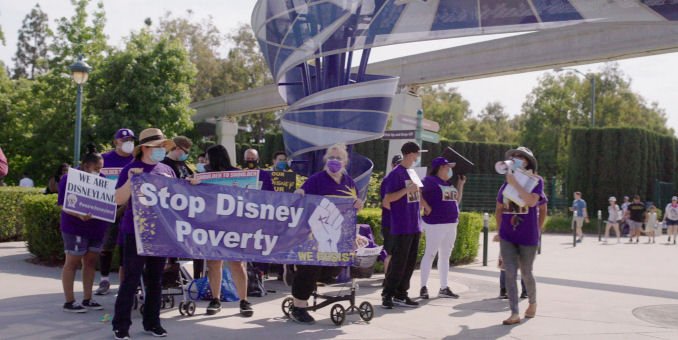The American Dream And Other Fairy Tales premiered this past January at the Sundance Film Festival, where we original reviewed. The movie goes into limited release and becomes available on VOD tomorrow, Friday September 23.
It feels almost trite to say after watching The American Dream And Other Fairy Tales that Disneyland is the happiest place on Earth, except if you happen to be employed there. As park employees struggle to make ends meet on the meager salary they receive while upper management makes several thousand times that amount, it feels as if it is doing them a disservice by utilizing such a pithy summation.
But the facts are hard to dispute. Where it was once possible for a park employee to own a home and support a family through their work, one in ten current Disneyland employees have had to live in their car at some point and two-thirds of them have had to reply on various forms of food assistance programs. Disney may try to deflect criticism by saying that they provide health benefits for their employees, but the park workers interviewed for the film will tell you that the premiums are unaffordable. For a company that had one of its most profitable years in 2019, very little of that has trickled down to the people who did the work that delivered that prosperity.
Needless to say, co-director Abigail Disney is very much a part of the story of the documentary itself. As the granddaughter of Disney co-founder Roy Disney and grand niece of Walt, she brings a unique insight and authority into the mindset of the founders of the Walt Disney Studios empire, their philosophy for treating their workers and the changes in attitude that the company’s subsequent management company have gone through. She also has the access to try to address those changes with that management, in the form of now-departed CEO Bob Iger, who never replied to emails she sent to him on the issue.
But American Dream isn’t just a look at the hardships facing many of the rank-and-file part employees. Instead, it sees what is going on at the Disney park as indicative of a whole shifted mind set in American business. Disney looks back at the income difference between her grandfather and his employees being at under 80 times what they made to the much wider gulf that exists today. It traces the post-World War Two middle class boom of the 1950s and 60s to the union busting, “greed is good,” “trickle down economics” of Ronald Reagan’s 1980s. Much of the blame for the shift away from business, labor and government working somewhat in tandem for the common good to an economy that centered more on corporate profits to exclusion of all else lies on politicians leveraging anti-governmental feelings following the Vietnam War and embracing the morally devoid “greed is good” philosophy of economist Milton Friedman.
And while American Dream does a great job at laying out the issues in the micro for the Disneyland employees and the macro for the rest of us toiling away in corporate America, that is about as far as Disney takes it. Much of the information here is nothing new. (It seems as if at least once a year for the last several years someone has released a study showing that Reagan’s trickle down economics theory was a failure.) They have outlined the problem, given very real faces to those impacted by it and the danger of it continuing to grow. But they don’t really offer a solution. Is there even a solution to be found or has the country already passed some critical point-of-no-return? It is troubling to see Disney try to explain how business and government worked in the 1950s to a congressional committee only for some congressman accuse her of wanting “socialism,” as if he had any idea of what he was actually talking about. The larger economic woes that the country is suffering through are certainly nothing that Tinkerbell can sprinkle some magic fairy dust on to remedy. For answers, we will need to look somewhere else.



